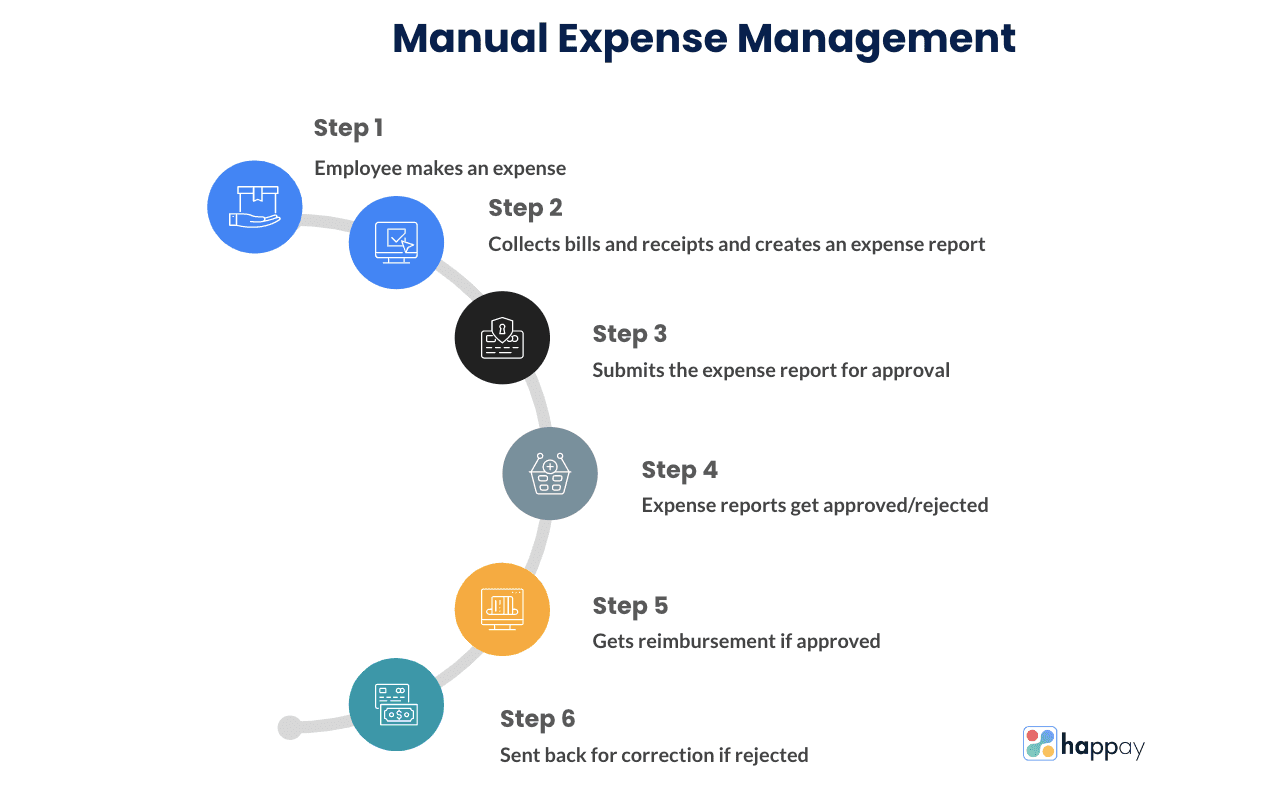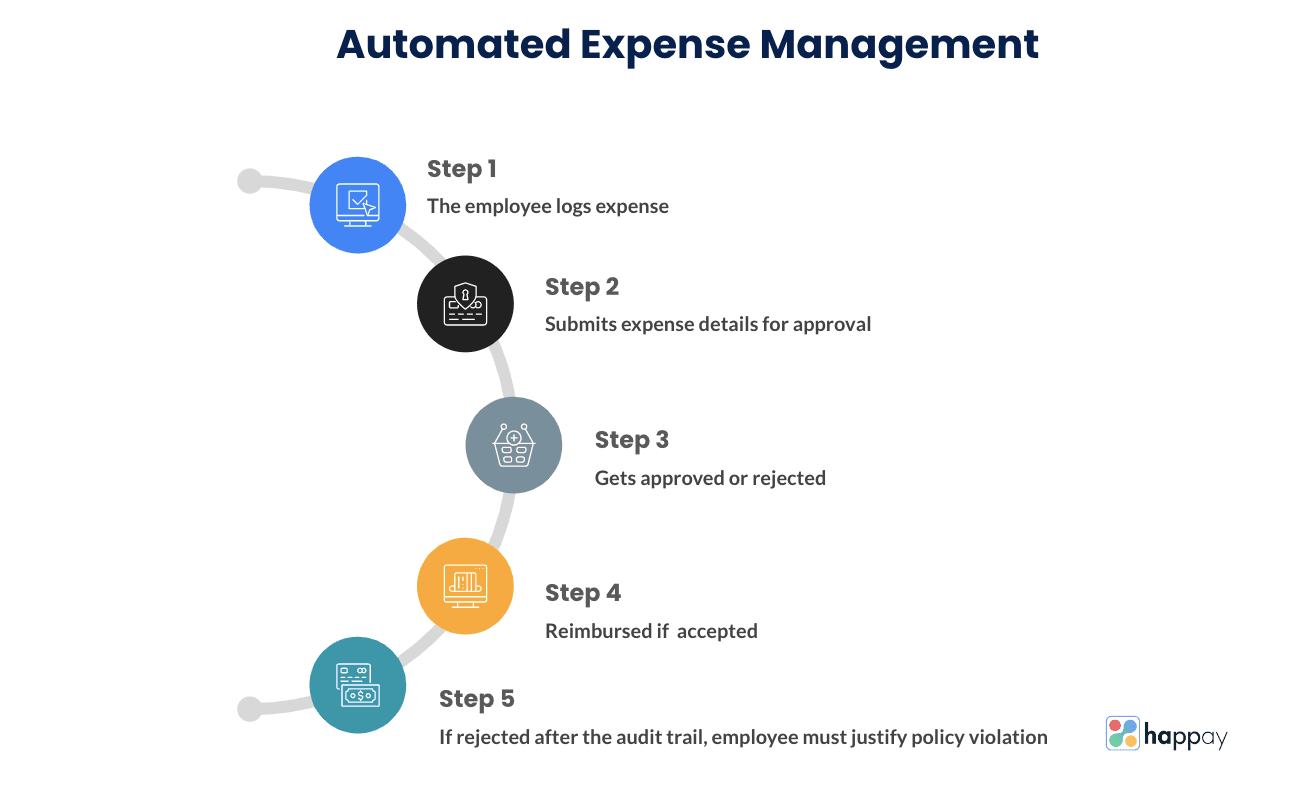Last Updated on November 28, 2025
Expense management in an enterprise is no simple feat. You need to constantly keep track of your expenses, find innovative ways to control them, and ensure the expenses comply with your organization’s policies.
Despite being the second-most challenging cost after employee salary, expenses in most organizations are still managed manually. Tallie’s expense trends report states that 43% of companies are still managing expense reporting manually.
Are you looking for ways to make your firm’s expense management robust and error-free? From what expense management is to how to automate expense management, we are breaking down everything you need to know in this blog. Keep reading to know more.
Also, Read: A Guide to Travel and Expense Management
Expense management
Expense management can make or break your company’s finances. Most finance/accounting heads and employees describe expense reporting and expense management as time-consuming, laborious, and error-prone.
However, you cannot deny that expense management plays a crucial role in your company’s financial health and the smooth running of your organization. Therefore, it is important that you fully understand the process and manage it efficiently.
Suggested Reading: How to manage travel expenses in an organization?
What is expense management?
The multi-step process of working with expense reports, expense approval, and employee reimbursements is called expense management.
However, expense management is not just restricted to these steps. The implementation of T&E policies in your firm, auditing expenses, and how the company will reimburse employees also come under expense management.
In most organizations, business expenses are managed manually, using spreadsheets and paperwork, or the process is automated using expense management software.
Expenses come in different forms for enterprises. They are broadly categorized into these four categories:
- Variable expense: These expenses vary each month. Telephone bills, water, electricity, and other utilities are variable expenses
- Fixed expense: As the name suggests, this includes fixed expenses such as salaries, rent, insurance, etc.
- Periodic expense: Expenses that do not occur regularly and occasionally come under this category. Some examples of periodic expenses are repair costs, license renewals, Saas expenses, etc.
- Discretionary Expense: Expenses made at the sole discretion of the management are called discretionary expenses
Read More – What Are Business Expenses?
Types of expense management
Companies resort to multiple ways to manage expenses. Here are some of the most common expense management types:
a) Paper forms:
If you are looking for an inexpensive and manual way to manage expenses, then paper forms is the way to go. However, there is a downside here – this type of expense management negatively affects the efficiency of your organization.
b) Spreadsheets:
Some companies use spreadsheets to manage expenses manually. In this type, paper receipts are added along with the spreadsheet.
c) Software:
Using expense management software is the best choice to manage your organization’s expenses efficiently and effectively.
Here’s a quick video on making your travel expense system efficient!
Why is expense management important?
When expense management is efficient in an organization, it will ultimately benefit all the stakeholders in your company. For example, a robust expense process will ensure employees receive their timely reimbursement.
In the case of the finance team, it helps them maintain the accounts accurately and increase policy compliance. As a CFO, well-defined expense management will make expense tracking more powerful for you.
Also, Read: Top 10 Expense Management Tips for Your Business
Traditional expense management process
In traditional expense management, the entire process relies on spreadsheets, paper bills, receipts, etc. In companies that follow the traditional expense management system, this is how the manual process looks like:
- Employees must submit the manually filled expense reports and hard copies of bills, receipts, and invoices for approval
- This expense report is then forwarded to the department head. The approver approves or rejects the claim
- The claim is then sent to the finance department for audit to ensure it complies with the firm’s business travel and expense policy. If it is a policy-compliant expense claim, the finance team will approve it. If not, the team will reject it. Finally, they store receipts, bills, and other essential documents for tax purposes

Automated expense management process
Every step in this expense management method is fully automated, from filing expense reports to setting up policy checks to approving reimbursement. Another great advantage is that automated expense management software will streamline your expense reporting, processing, and reimbursement process.

Related reads: Employee expense reimbursement law: Everything you need to know
Traditional vs. Automated expense management
Traditional expense management methods are no match for automated expense management. Here are some of the fields where automated expense management outperforms traditional expense management methods:
1. Errors:
Most expense management software uses OCR and automatic expense capture features. Therefore, manual errors in an automated expense management system are fewer. On the other hand, traditional expense management systems are infamous for such errors.
2. Expense fraud:
Let us accept it. Old and archaic expense management systems are the breeding ground for expense fraud. Employees will easily use the loopholes in this method and submit fraudulent expense reports. At the same time, policy checks set in the automated software will efficiently detect fraudulent expense claims.
3. Compliance:
In automated expense management software, you can automatically set policies and detect non-policy-compliant reports. This will help increase policy compliance in your firm.
However, in the case of manual expense management systems, the finance staff must go through every single expense report to check for compliance.
4. Approval time:
Approval processes are faster in automated systems when compared to the traditional method.
5. Real-time data:
An automated expense management system offers you real-time expense data. As a CFO, you can view the expenses based on categories, departments, vendors, etc., and use this data to control spending and forecast the budget. This is not possible in traditional expense management systems.
Read More: Expense Management Workflow Process
Challenges in the expense management process
Here are the top challenges in the expense management process:
1. Unclear expense policies
Unclear expense policies create a ton of problems in your company. If your employees are unsure about what kind of expenses are acceptable, they are bound to make mistakes while claiming reimbursement.
2. Poor expense visibility
Organizations that do not have access to expense data and information will not be able to make crucial decisions. For example, if you don’t have insights on which vendor does the most business transactions with you, it is impossible to negotiate better rates with that vendor.
3. Inefficient process
Is the expense management process in your organization efficient? Can it process hundreds of expense reports submitted by your employees? If not, it is time to use efficient technology to make the process faster and error-free.
4. Delay in employee reimbursement
What is the average employee expense reimbursement time in your firm? If your finance team takes forever to reimburse the claims, it will eventually affect the morale and productivity of your employees.
Also, Read: 7 Top Expense Management Challenges and How to Avoid Them
Best practices to streamline your expense management process
Here are some of the best expense management practices that CFOs and finance managers must know:
1. Create an expense policy
An expense management policy helps manage expenses efficiently. An organization’s expense policy defines what expenses can be reimbursed and what cannot be, how the employees will be reimbursed, and other important information.
2. Expense management software
Manual expense management processes are time-consuming and laborious. Picking the right expense management software is the key to managing your expenses efficiently. Check out the features of all the expense management solutions in the market and pricing. Finally, choose what suits best for your organization.
3. Automated expense audits
Expense management systems with automated expense audits will instantly flag fraudulent reports, duplicate claims, and fake bills. Pick an expense management system with this feature to fix cash leakage in your firm.
4. Corporate credit cards
Corporate credit cards make reconciliation a breeze. It speeds up expense filing, reporting, and reimbursement processes.
Want to know what are the other expense management best practices that CFOs must know?
Check out our 9 Expense Management Best Practices for CFOs blog now.
What is expense management software?
An expense management software is an application that automates your organization’s expense reporting, processing, and reimbursement process, removes all manual effort, and makes it efficient and more straightforward.
Additionally, expense management software ensures policy compliance for every expense report in your firm. This means goodbye to non-policy expense reimbursements.
Why do you need automated expense management software?
From 100% expense tracking to faster reimbursements, there are multiple benefits of expense management software. Let us take a look at some of them:
1. The efficient expense reporting process
Almost all expense management apps these days come with built-in OCR. The OCR tech will allow your employees to file paperless expense reports on the go without any hassle.
Additionally, automated spend management systems will auto-capture expenses from different sources, such as emails, text messages, invoices, etc., and auto-populate the expense report. All employees need to do is check it once and submit it with just a single click.
2. Create custom automated workflows
With automated custom workflows, employees no longer have to constantly remind their managers and the finance department to approve expense reports. Automating workflows can eliminate bottlenecks and fasten the reimbursement claim process.
3. Higher policy compliance
Automated expense management systems will identify and red-flag reports that violate your company’s T&E policy. Approvers can view the policies being violated and then decide whether to accept or reject the report accordingly.
4. Access real-time data
An automated expense management system offers you real-time expense data. As a CFO, you can view the expenses based on categories, departments, vendors, etc., and use this data to control spending and forecast the budget.
Read More: What is Spend Management?
How to choose the best expense management system for your organization?
Looking for the best expense management system for your company? We recommend you conduct in-depth research on features offered by all the available expense management systems out there before choosing one. Want some help? Here’s a list of features that a good expense management system must have:
1. Accessible through the website and mobile app
Picking an expense management system with a user-friendly mobile app is a no-brainer. Using the expense management app on their phones, your employees can record and report expenses on the go. What’s more, department heads and approvers can approve the requests using the mobile app without any effort.
2. Approval workflows that can be customized
Choose an expense management system that allows you to add and customize approval workflows that suits your organization. A well-defined workflow will ensure the employees’ expense reports reach the right people at the right time.
3. Automates your T&E policy
Go for an expense management system that allows you to automate your company’s expense policy fully. This way, you can make sure all the expenses caused by your employees comply with your expense policy without any manual intervention.
4. Offers credit card reconciliation
Most expense management software comes with credit card reconciliation. Your finance team no longer has to match the credit card statements to bills and look for compliance. We all know matching credit card statements to bills and auditing them for compliance is an arduous task.
5. Real-time and in-depth analytics
Automated expense management systems offer you real-time data on employee spending across organizations. View each department, category, project, and employee expense data under one dashboard. Finally, make strategic decisions using the data obtained in this dashboard.
6. Integration into other systems
Choose an expense management software that allows you to seamlessly integrate it into other existing systems in your company, like travel desk, HRMS, ERP, and accounting software.
Read More: Expense Management Workflow Process
Automate your expense management with Happay
Happay is mobile-first, automated, intelligent travel & expense management software that makes expense filing, capturing, processing, and reimbursement hassle-free and simple.
With Happay, manage all your expenses under one single platform and easily integrate them into other systems such as ERP, HR, and accounting systems without any effort.
Check out the unique features of Happay that lets you manage your expense better:
1. Superior OCR technology:
With Happay’s state-of-the-art OCR technology, auto-scan bills and expense receipts with just mobile devices and create an expense without lifting a finger. The OCR feature will capture essential data like invoice number, vendor details, items, amount, date, GSTIN, etc.
2. Auto-capture expenses from different sources:
Happay’s AI Engine XPENDITE accurately auto-captures expense data from multiple sources like SMS, credit card statements, Uber, Gmail, Outlook, WhatsApp, and other apps with full accuracy.
3. Audit expenses effectively:
With Happay, seamlessly configure your firm’s business rules and expense policies into the system. Happay’s Smart Audit feature will catch duplicate bills, amount mismatch errors, date mismatch, overstated expenses, and auto flags restricted items. This will ensure that non-policy-compliant expenses don’t get approved.
4. Trigger right deviation workflow:
Happay will trigger the right deviation workflow for non-policy-compliant approvals. What’s more, it will also notify approvers of expense reports within seconds after submission. On Happay, you can now handle multiple levels of hierarchy effortlessly.
5. Enjoy the power of Happay’s mobile app:
Employees can now create expense reports in just a single click – no emails and no excel sheets. Approve expense claims on the go using the mobile app, anywhere, anytime.
6. Get 100% expense visibility:
Happay’s Smart Analytics gives you complete visibility of travel and expense on the same platform. This feature offers detailed reports to analyze spending, policy violations, compliance adherence, and efficiency details.
Want to know more about Happay’s money-saving features? Schedule a demo with us today.
Suggested reading: Beyond Budgets: A Guide to Project Expense Management
FAQs
Expense management system is a software application that allows employees in a company to report expenses, process, audit, and reimburse. An expense management system automates all processes in expense management.
Here are four easy steps to manage expense reports in an enterprise:
1. Draft a clear expense report policy and encourage employees to follow it
2. Ensure expenses are easy to report and track
3. Allot corporate credit for easy reconciliation
4. Audit expenses regularly
Here are some of the top benefits of expense management:
a) Simple and fast reporting and reimbursement process
b) Fewer inaccuracies and delays
c) Prevention of expense fraud
d) Improved compliance
1. Create an accountable expense reimbursement plan
2. Ensure you create a transparent outline
3. Issue corporate credit cards to manage employee expenses
4. Create a user-friendly expense reporting template










Discussion about this post